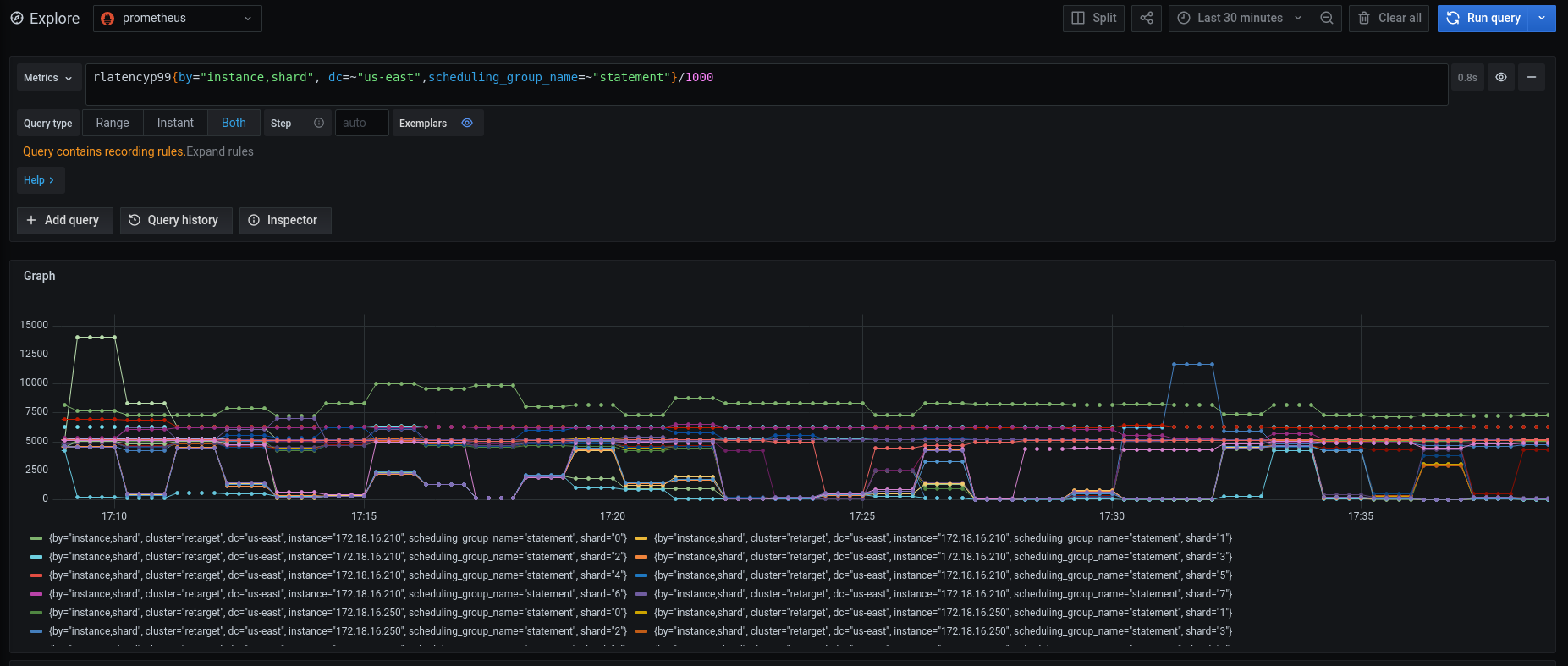Scaling trouble
Robert Hayre
<robert@rtbiq.com>I am running a DC with 9 i3.2xlarge instances running the stock ScyllaDB 4.3.1 AMI in AWS EC2 in a single availability zone.
The read pattern consists of LOCAL_ONE queries that target single partitions and return all rows, amounting to payloads averaging much less than one kilobyte, but with some payloads over this size. The client is the official Python cassandra-driver, although I have tried scylla-driver to no effect. This client employs the usual TokenAwarePolicy(DCAwareRoundRobinPolicy). There are about 500 processes across many nodes with their own shared client instance.
Given these provisions and the data/query model, I would expect the “rule-of-thumb” to be at play here, where let’s say 10k ops/sec comes from each physical core in the cluster, so 9 nodes x 4 phys. cores per node x 10k ops/core = 36k ops/sec.
However, there is clearly a problem that manifests as timeouts on the client side, and obviously high read latency (in the seconds at p99) as reported by nodetool and as evidenced in the Scylla Monitoring Stack that I recently set up. Please see the attached snapshot of the “Overview” dashboard, where reads/sec is at a modest 17k/sec. The high latency tail disappears at some lower threshold of reads/sec.
Does this seem strange to anyone? I’m likely to have missed some important information or data, which I’d be glad to provide.
Thanks,
Robert

Tomer Sandler
<tomer@scylladb.com>Tomer Sandler
ScyllaDB
(Sent from my android)
--
You received this message because you are subscribed to the Google Groups "ScyllaDB users" group.
To unsubscribe from this group and stop receiving emails from it, send an email to scylladb-user...@googlegroups.com.
To view this discussion on the web visit https://groups.google.com/d/msgid/scylladb-users/d71162d9-6d6e-411e-a591-a74cf3f181e4n%40googlegroups.com.
Tomer Sandler
<tomer@scylladb.com>Tomer Sandler
ScyllaDB
(Sent from my android)
Robert Hayre
<robert@rtbiq.com>Avishai Ish Shalom
<avishai.ishshalom@scylladb.com>Robert Hayre
<robert@rtbiq.com>Regarding the number of connections per shard: There are about 500 separate processes with their own Cluster instance, and there are 8 shards per i3.2xlarge node.
As an update, there was a crash that led to losing several nodes, and new nodes were only able to bootstrap after upgrading to Scylla 4.4.4. There are now 5 i3.2xlarge nodes running the official AMI.
To respond to Avishai’s request, here is the table schema:
CREATE TABLE ks.cf (
i ascii,
A ascii,
B ascii,
C ascii,
D text,
t timestamp,
PRIMARY KEY (i, A, B, C, D, t)
) WITH CLUSTERING ORDER BY (A ASC, B ASC, C ASC, D ASC, t ASC)
AND bloom_filter_fp_chance = 0.01
AND caching = {'keys': 'ALL', 'rows_per_partition': 'ALL'}
AND comment = ''
AND compaction = {'class': 'TimeWindowCompactionStrategy', 'compaction_window_size': '3', 'compaction_window_unit': 'DAYS', 'tombstone_compaction_interval': '7776010'}
AND compression = {'sstable_compression': 'org.apache.cassandra.io.compress.LZ4Compressor'}
AND crc_check_chance = 1.0
AND dclocal_read_repair_chance = 0.0
AND default_time_to_live = 7776000
AND gc_grace_seconds = 10
AND max_index_interval = 2048
AND memtable_flush_period_in_ms = 0
AND min_index_interval = 128
AND read_repair_chance = 0.0
AND speculative_retry = 'NONE';
The following snippet shows the connection setup and describes the read pattern:
session = Cluster(
['cluster.dns.name'], port=19042,
execution_profiles={EXEC_PROFILE_DEFAULT: ExecutionProfile(load_balancing_policy=TokenAwarePolicy(DCAwareRoundRobinPolicy()))}
).connect()
insert = session.prepare('INSERT INTO ks.cf (i, A, B, C, D, t) VALUES (?, ?, ?, ?, ?, ?)')
insert.consistency_level = ConsistencyLevel.LOCAL_QUORUM
get = session.prepare("SELECT A, B, C, D, count(*), max(t) FROM ks.cf WHERE i = ? GROUP BY A, B, C, D")
get.consistency_level = ConsistencyLevel.LOCAL_ONE
Is this a rather heavy query?
To give an example of threshold behavior, here is a DC Overview below the threshold where problems occur:
And here is an Overview somewhere above the threshold (which must be between 7,500 ops/sec and 30,000 ops/sec):

Also, here is a view of the p99 latency in milliseconds, where groups of shards are in the single-digit seconds, and these shards seems to be grouped on nodes with disproportionate load:

These snapshots are in a case where load only emanated from 5 client instances with about 170 processes/connections.
I hope this is helpful towards understanding the situation!
Best,
Robert
